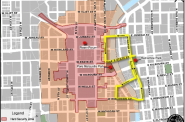12 Takeaways From City’s 2022 Budget
What's in the 600 page, $1.75 billion budget document? An inside look at your city government.
Mayor Tom Barrett unveiled his 2022 budget proposal Tuesday morning. And while Barrett could deliver a summary in less than 10 minutes, the actual underlying documents are more than 600 pages long and contain more than $1.75 billion in spending.
Here’s an insider’s look at the budget’s key facts and figures and what it tells us about the city and its government:
1. Wisconsin Is Defunding Milwaukee
The State of Wisconsin plays a key role in Milwaukee’s revenue structure. It caps its property tax revenue, prohibits new taxes and increasingly is keeping more of the income tax dollars generated in the city.
If the 2003 figure was adjusted for inflation and left as is, the city would be receiving an additional $118.5 million annually. That creates a massive hole in the city budget.
2. Looming Pension Crisis
The looming fiscal cliff doesn’t appear directly in the budget, but every decision made about the 2022 budget will be evaluated through the lens of needing to come up with tens of millions more dollars annually starting in 2023.
Barrett’s proposal calls for an additional $10 million to be contributed to the pension reserve fund in 2022, bringing its balance to $52 million. But that entire amount would be wiped out in 2023 and the city would still need to come up with at least $10 million more. Then it would need to find $70 million in 2024 and every year after that.
An earlier 2021 report warned that without any change, one in every six city employees could be laid off by 2027. A pension task force is expected to present recommendations soon to address the problem, but everyone seems to agree that any pathway out of the problem must involve state help.
3. Fourth of July Commission Is Back
A missing item from the 2021 budget will be back in 2022. The Milwaukee Fourth of July Commission, which funds Independence Day activities in neighborhood parks throughout the city, will again receive $125,000. The fireworks will return!
The 2021 allocation was suspended, amid the pandemic, with the unspent 2020 funds being used to cover the gap.
4. Dogs, Cats and City Cash
And while the city spends money on bombs bursting in air, it collects money from dog and cat owners.
The 2022 budget calls for $92,000 in revenue from dog and cat licenses, down from $99,000 in 2021 and actual collections of $85,597 in 2020.
Fees are $18 per altered (neutered) dog or cat and $36 per unaltered pet.
But the fees don’t come near to covering the city’s share of funding MADACC. The 2022 budget calls for a $1.87 million transfer to the nonprofit, to be funded entirely by a lost revenue provision of the American Rescue Plan Act.
5. The Slots Pay for Milwaukee
Potawatomi Hotel & Casino in the Menomonee Valley pays dividends for the city’s finances. The Forest County Potawatomi tribe, according to the budget, is expected to pay the city $5.75 million in 2022 as part of its gaming compact with the state.
That revenue excludes the streetcar sponsorship agreement (~$800,000 annually) and property tax revenue from its non-casino properties. The hotel and conference center, the fourth most valuable property in the city, is assessed for $97.2 million. As a result of its assessment, the two-building hotel complex has an approximately $3 million property tax ball, with $1 million going to the city.
6. 209 Fewer Positions
Despite the fact that the total budget figure continues to grow, the city’s workforce has been steadily shrinking for decades.
The biggest department, with 2,753 authorized positions, would continue to be the Milwaukee Police Department, followed by the Department of Public Works (1,674) and Milwaukee Fire Department (867). And while the sworn strength of the police department is expected to decline by 25 over the course of 2022, the number of authorized positions in the department would increase by 21.
The biggest department cut in 2022 will be the health department, which is posed to lose 252 positions. That would leave the department with 385 positions, still up from 285 pre-pandemic.
7. General Fund
The budget is $1.75 billion, but the bulk of budget debate will be concentrated on the $634 million general fund that is available for a flexible range of city services.
That fund is made up for intergovernmental revenue (35.9%), property tax revenue (28.8%) and service fees (22%) in addition to a series of smaller sources.
“A majority of the general fund is allocated to police, fire and public works,” says the budget plan in a line that has been repeated for multiple years. But for the first time since 2015, the police department budget won’t exceed the entire property tax levy. Part of that is due to the creation of a new 9-1-1 (emergency communication) department, as well as a reduction in the number of sworn officers.
What accounts for the other $1.1 billion of the city budget? A total of $256 million is proposed for debt service, $215 million of spending associated with grants and aid, $150 million for the Milwaukee Water Works, $136 million for capital improvements, $122 million to employee retirement (including employee contributions), $112 million for sewer maintenance and a number of smaller areas.
8. Library Hours
It’s going to be a little bit harder to get to the Milwaukee Public Library in 2022 under Barrett’s proposal. The only library offering Sunday hours will be the Central Library from October through April. Previously three libraries were open on Sunday.
All 12 branch libraries would be standardized at 48 hours per week of operation. Central Library would see its open hours cut from 54 per week to 52.
Circulation and patronage, according to a graph included in the budget, declined from 2012 to 2019. Annual patronage fell from nearly 2.5 million to approximately 1.6 million.
The department report includes an expectation that digital and non-traditional resource use will continue to grow. It also references a planned “collaborative business commons space” (co-working) in addition to its workforce development programs.
The 2022 budget calls for $26.47 million to be spent on library services and operations.
9. The Rising Value of a Milwaukee Home
The average residential property in the City of Milwaukee is valued at $127,900 according to the 2022 budget proposal. That’s up from $126,235 in the year prior.
That average homeowner would see the city share of their property tax bill grow by $33 in 2022. The total property tax levy will grow by 2% to $305 million.
Individual homeowners should get ready for some shock therapy in late 2022. After suspending the process for a year, the Assessor’s Office will again conduct a citywide re-evaluation of property values. The process, required by law to mirror market data and designed to be equitable, effectively boosts tax bills in areas seeing increasing prices and shrinks them in areas where home prices are falling.
But that doesn’t spell a cash windfall for the city due to property tax levy limits. It only changes what percentage of the bill each property owner pays.
10. An Expanded Lead Poisoning Response
Buried in the budget is a proposal to expand the Milwaukee Health Department’s effort to combat childhood lead poisoning.
The Coalition on Lead Emergency is proposing the threshold be lowered to five and estimates that doing so would add 1,860 annual cases to the city’s abatement workload.
The Milwaukee Health Department estimated it would contract out 154 abatements in 2020 at a cost of $20,000 to $25,000 each. Much of the work is already federally funded through a multi-year grant.
Barrett’s proposal calls for $26.1 million in American Rescue Plan Act funding to cover the costs in 2022 and $68 million across three years.
11. ACLU Settlement Still Costing Money, But Other Settlements Cost Even More
The proposed budget includes a $300,000 line item for compliance with a 2018 police settlement. The line item funds a consultant to ensure the city is complying with the more than 40 pages of terms associated with the Collins vs. Milwaukee settlement agreement.
The measure is, however, only the tip of the iceberg on police settlements. The city is paying hundreds of thousands, if not millions, annually to repay debt associated with other settlements. But those settlements don’t get specific line items, nor do they appear in the police budget.
12. Parking Tickets Will Surge
If you read this article to the end, you should probably check that your parking meter hasn’t run out. The 2022 budget calls for $16 million to be derived from 600,000 parking tickets, up $600,000 from 2021 and doubling 2020’s pandemic-devasted collections.
The city also expects to collect $24 million in parking revenue, including $5.55 million from city-owned lots and garages, $4.55 million from permits, $5.24 million from meters, $4 million from towing and $2.6 million from vehicle disposal. The tax revenue intercept program, where the state intervenes in income tax filings for individuals with more than $40 in unpaid citations, is expected to generate approximately $2 million.
The transportation fund as a whole would generate $41 million in revenue, $10 million of which would be transferred to the general fund.
The streetcar would be funded with $4.6 million from the transportation fund, including $1.44 million it would generate from sponsorship agreements. The Hop is not funded with property tax revenue.
Looking for big picture coverage of the budget proposal? See our earlier coverage.
If you think stories like this are important, become a member of Urban Milwaukee and help support real, independent journalism. Plus you get some cool added benefits.
More about the 2022 Milwaukee buget
- City Hall: The Council’s War With Tearman Spencer - Jeramey Jannene - Nov 23rd, 2021
- City Hall: Council, Mayor At Odds Over City Attorney - Jeramey Jannene - Nov 16th, 2021
- City Hall: Milwaukee Adopts ‘Calm Before The Storm’ 2022 Budget - Jeramey Jannene - Nov 5th, 2021
- City Hall: Committee Recommends Few Budget Amendments - Jeramey Jannene - Oct 28th, 2021
- City Hall: ARPA Funding May Delay City’s Fiscal Cliff Says Policy Forum - Jeramey Jannene - Oct 19th, 2021
- City Hall: Homicides, Shootings, Auto Thefts All At Record Highs - Jeramey Jannene - Oct 11th, 2021
- Groups Call For Defunding the Police To Solve Milwaukee Pension Crisis - Jeramey Jannene - Oct 1st, 2021
- City Hall: 12 Takeaways From City’s 2022 Budget - Jeramey Jannene - Sep 22nd, 2021
- City Hall: Barrett Unveils 2022 Budget Proposal - Jeramey Jannene - Sep 21st, 2021
- City Hall: 2022 City Budget Process Kicks Off - Jeramey Jannene - Aug 17th, 2021
Read more about 2022 Milwaukee buget here
More about the American Rescue Plan Act
- Homes MKE Putting First-Time Buyers Into Rehabbed Homes - Nick Rommel - Nov 21st, 2024
- MKE County: As Deadline Looms, County Should Shift Stimulus Funding - Graham Kilmer - Dec 8th, 2023
- A Mix of Speed Hump and Crosswalk, New Street Feature All About Safety - Jeramey Jannene - Oct 30th, 2023
- Transportation: Construction Underway on Traffic Calming Projects - Jeramey Jannene - Oct 12th, 2022
- Eyes on Milwaukee: City Seeking Affordable Housing Developers Who Need Funding - Jeramey Jannene - Jul 25th, 2022
- Transportation: Milwaukee Seeks Partners On Project Lowering Speed Limits - Jeramey Jannene - Jul 1st, 2022
- City Hall: ARPA Funds Can’t Plug City Budget Hole - Jeramey Jannene - Jun 15th, 2022
- Plats and Parcels: City Seeks Firms To Transform Vacant Homes - Jeramey Jannene - May 1st, 2022
- Transportation: DPW Plans Surge of Traffic-Calming Bump Outs - Jeramey Jannene - Apr 26th, 2022
- City Hall: Federal Grant Could Help Stave Off 1,300 Layoffs - Jeramey Jannene - Apr 14th, 2022
Read more about American Rescue Plan Act here
More about the Lead Crisis
- Gov. Evers Approves Bill to Support Lead Service Line Replacement in Superior - Gov. Tony Evers - Jul 1st, 2025
- MPS’s Westside Academy Cleared of Lead Risks After Stabilization Work - Milwaukee Public Schools - Jul 1st, 2025
- MPS Plans Lead Remediation at 40 Schools This Summer - Evan Casey - Jun 27th, 2025
- Baldwin, Reed Demand Written Answers from RFK, Jr. on Firings of Childhood Lead Poisoning Experts at CDC - U.S. Sen. Tammy Baldwin - Jun 11th, 2025
- MPS’s LaFollette School Cleared of Lead Risks After Stabilization Work - Milwaukee Public Schools - Jun 11th, 2025
- Sen. Baldwin Hears From Parents About MPS Lead Crisis, Chides RFK Jr. - Evan Casey - Jun 9th, 2025
- Reps. Margaret Arney and Darrin Madison Urge Joint Finance Committee to Reinstate Essential Lead Abatement Funding - State Rep. Margaret Arney - Jun 5th, 2025
- Gov. Evers, DHS Continue Administration’s Efforts to Combat Lead Poisoning Statewide with Permanent Rule - Gov. Tony Evers - May 27th, 2025
- RFK Jr. Claims ‘Team’ Is In Milwaukee Helping With Lead Crisis, Health Department Can’t Find Them - Nick Rommel - May 22nd, 2025
- MPS Announces Starms Early Childhood Center Is Cleared of Lead Dangers - Milwaukee Public Schools - May 21st, 2025
Read more about Lead Crisis here
























